While pessimism is not in short supply in Pakistan, other resources are increasingly scarce. This is driving the country toward a crisis characterized by interlocking economic, political and security dimensions, and has already brought the government close to fiscal collapse.
Yet the dangers are poorly understood. Few of the country's policy elite fully grasp how Pakistan's energy, food and fiscal challenges intersect, nor how quickly problems will spiral as the country's population grows. Meanwhile, the international community is equally fragmented and short-term in its outlook, still working through sector-based silos that leave it unable to see the big picture. With regard to Pakistan, the United States, along with other international actors, still lacks a coherent vision for what it can do to help build a more stable state. On the global stage, Washington has barely begun to address the impact that an era of higher and more volatile resource prices will have on countries such as Pakistan that are both fragile and strategically significant.
In 2011, popular uprisings throughout the Middle East finally made it respectable to admit that resource scarcity will be a major driver of global change in coming decades, as high food prices proved a major irritant for the region's young population already starved of other opportunities. There is more turbulence to come. Over the next 15 years, the world's population will increase from almost 7 to almost 8 billion people. The "next billion" will be Asian or African, and most will live in unplanned, and often chaotic, towns and cities. They will face fierce competition for resources from the rich world, long accustomed to dominating commodity markets, as well as from increasingly assertive middle classes in China, India, Brazil and the other rising powers.

